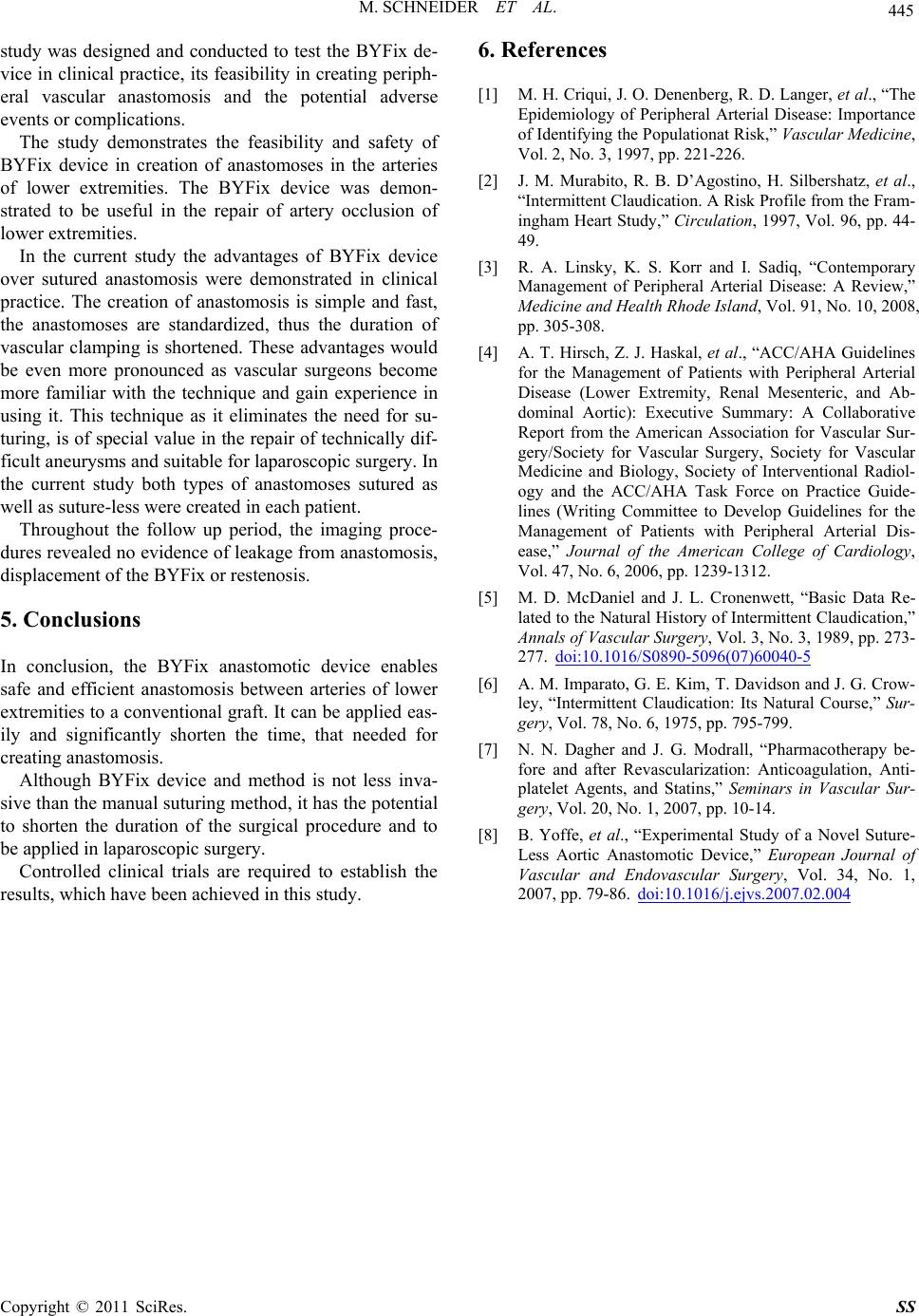
M. SCHNEIDER ET AL.
Copyright © 2011 SciRes. SS
445
study was designed and conducted to test the BYFix de-
vice in clinical practice, its feasibility in creating periph-
eral vascular anastomosis and the potential adverse
events or complications.
The study demonstrates the feasibility and safety of
BYFix device in creation of anastomoses in the arteries
of lower extremities. The BYFix device was demon-
strated to be useful in the repair of artery occlusion of
lower extremities.
In the current study the advantages of BYFix device
over sutured anastomosis were demonstrated in clinical
practice. The creation of anastomosis is simple and fast,
the anastomoses are standardized, thus the duration of
vascular clamping is shortened. These advantages would
be even more pronounced as vascular surgeons become
more familiar with the technique and gain experience in
using it. This technique as it eliminates the need for su-
turing, is of special value in the repair of technically dif-
ficult aneurysms and suitable for laparoscopic surgery. In
the current study both types of anastomoses sutured as
well as suture-less were created in each patient.
Throughout the follow up period, the imaging proce-
dures revealed no evidence of leakage from anastomosis,
displacement of the BYFix or restenosis.
5. Conclusions
In conclusion, the BYFix anastomotic device enables
safe and efficient anastomosis between arteries of lower
extremities to a conventional graft. It can be applied eas-
ily and significantly shorten the time, that needed for
creating anastomosis.
Although BYFix device and method is not less inva-
sive than the manual suturing method, it has the potential
to shorten the duration of the surgical procedure and to
be applied in laparoscopic surgery.
Controlled clinical trials are required to establish the
results, which have been achieved in this study.
6. References
[1] M. H. Criqui, J. O. Denenberg, R. D. Langer, et al., “The
Epidemiology of Peripheral Arterial Disease: Importance
of Identifying the Populationat Risk,” Vascular Medicine,
Vol. 2, No. 3, 1997, pp. 221-226.
[2] J. M. Murabito, R. B. D’Agostino, H. Silbershatz, et al.,
“Intermittent Claudication. A Risk Profile from the Fram-
ingham Heart Study,” Circulation, 1997, Vol. 96, pp. 44-
49.
[3] R. A. Linsky, K. S. Korr and I. Sadiq, “Contemporary
Management of Peripheral Arterial Disease: A Review,”
Medicine and Health Rhode Island, Vol. 91, No. 10, 2008,
pp. 305-308.
[4] A. T. Hirsch, Z. J. Haskal, et al., “ACC/AHA Guidelines
for the Management of Patients with Peripheral Arterial
Disease (Lower Extremity, Renal Mesenteric, and Ab-
dominal Aortic): Executive Summary: A Collaborative
Report from the American Association for Vascular Sur-
gery/Society for Vascular Surgery, Society for Vascular
Medicine and Biology, Society of Interventional Radiol-
ogy and the ACC/AHA Task Force on Practice Guide-
lines (Writing Committee to Develop Guidelines for the
Management of Patients with Peripheral Arterial Dis-
ease,” Journal of the American College of Cardiology,
Vol. 47, No. 6, 2006, pp. 1239-1312.
[5] M. D. McDaniel and J. L. Cronenwett, “Basic Data Re-
lated to the Natural History of Intermittent Claudication,”
Annals of Vascular Surgery, Vol. 3, No. 3, 1989, pp. 273-
277. doi:10.1016/S0890-5096(07)60040-5
[6] A. M. Imparato, G. E. Kim, T. Davidson and J. G. Crow-
ley, “Intermittent Claudication: Its Natural Course,” Sur-
gery, Vol. 78, No. 6, 1975, pp. 795-799.
[7] N. N. Dagher and J. G. Modrall, “Pharmacotherapy be-
fore and after Revascularization: Anticoagulation, Anti-
platelet Agents, and Statins,” Seminars in Vascular Sur-
gery, Vol. 20, No. 1, 2007, pp. 10-14.
[8] B. Yoffe, et al., “Experimental Study of a Novel Suture-
Less Aortic Anastomotic Device,” European Journal of
Vascular and Endovascular Surgery, Vol. 34, No. 1,
2007, pp. 79-86. doi:10.1016/j.ejvs.2007.02.004